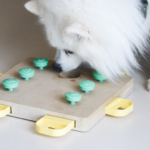Introduction
Maintaining a nutritious diet for your canine companion is fundamental to their overall well-being. In this guide, we delve into the nuances of canine nutrition, addressing common challenges and providing practical solutions to bid farewell to fussy eating habits. Our goal is to empower pet owners with insights that promote a healthier and more satisfying diet for their furry friends.
Understanding Canine Nutritional Needs
In the realm of canine well-being, understanding the essential nutrients that contribute to optimal health is paramount. Dogs, like humans, rely on a balanced diet to thrive and lead healthy lives. A holistic approach to their nutrition involves identifying key components that play a crucial role in their overall well-being.
Proteins: Proteins are the building blocks of life for dogs. They are essential for the development and repair of tissues, muscles, and cells. High-quality protein sources, such as meat, fish, and eggs, provide the amino acids necessary for robust growth and maintenance.
Fats: Dietary fats are vital for energy production and the absorption of fat-soluble vitamins. They contribute to healthy skin and coat, aid in hormone regulation, and provide a concentrated source of calories. Sources of healthy fats include fish oil, flaxseed, and chicken fat.
Carbohydrates: While dogs are primarily carnivores, carbohydrates play a role in providing a quick source of energy. Quality carbohydrates from sources like grains, vegetables, and legumes contribute to a well-rounded diet, supporting digestive health and sustained energy levels.
Vitamins: Vitamins are essential for various physiological functions, including immune support, bone health, and vision. Dogs require a mix of fat-soluble (A, D, E, K) and water-soluble (B-complex, C) vitamins. Balanced nutrition ensures they receive these vital nutrients in appropriate amounts.
Minerals: Minerals, such as calcium, phosphorus, and potassium, are crucial for bone health, nerve function, and overall metabolic processes. Maintaining the right balance of minerals is fundamental to prevent deficiencies or imbalances that may affect a dog’s health.
Challenges of Fussy Eating
Delving into the intricacies of canine nutrition, it’s not uncommon for pet owners to encounter the challenge of fussy eating behaviors in their dogs. Unraveling the reasons behind such tendencies requires a thoughtful exploration of various factors that may influence a dog’s appetite.
Picky Eating: Some dogs are inherently picky eaters, displaying discerning tastes that may be influenced by various factors, including past experiences, environment, or specific textures and flavors. Understanding and catering to their preferences can help alleviate picky eating habits.
Food Allergies: Food allergies or sensitivities can manifest as reluctance or refusal to eat certain foods. Common allergens include proteins like beef, chicken, or grains. Identifying potential allergens and opting for hypoallergenic alternatives can mitigate allergic reactions and improve the dog’s eating habits.
Medical Conditions: Underlying medical conditions, such as dental problems, gastrointestinal issues, or pain, can significantly impact a dog’s appetite. Regular veterinary check-ups are crucial for identifying and addressing any medical issues that might contribute to fussy eating.
Nutritional Deficiencies: Fussy eating behaviors can sometimes indicate nutritional deficiencies. Dogs may instinctively avoid certain foods if they lack essential nutrients. Recognizing signs of deficiencies, such as dull coat, lethargy, or weight loss, prompts adjustments to the diet to ensure it meets their nutritional requirements.
Practical Solutions for Picky Eaters
Encouraging healthy eating habits in dogs involves creating a positive and enjoyable mealtime experience. By implementing practical tips and strategies, pet owners can transform fussy eaters into enthusiastic diners.
Establish Consistent Mealtime Routines: Dogs thrive on routines, and establishing a consistent mealtime routine can signal to them that it’s time to eat. Set regular feeding times, and avoid leaving food out for extended periods. This helps regulate their appetite and reinforces a structured eating schedule.
Choose High-Quality, Nutrient-Rich Foods: Selecting high-quality, nutrient-rich dog food is paramount for their overall health. Opt for well-balanced options that include essential proteins, fats, carbohydrates, vitamins, and minerals. Consulting with a veterinarian can help determine the most suitable diet based on the dog’s breed, age, and specific health needs.
Introduce Variety in Their Diet: Dogs, like humans, appreciate variety in their meals. Introduce diverse protein sources, rotate between wet and dry food, and incorporate fresh fruits and vegetables as occasional treats. This not only adds nutritional value but also makes mealtimes more interesting for the dog.
Exercise Patience and Positive Reinforcement: Patience is key when dealing with fussy eaters. Avoid pressuring or scolding them during meals, as this can create negative associations with food. Instead, use positive reinforcement techniques. Praise and reward them when they eat well, creating a positive connection between mealtime and positive experiences.
Consider Interactive Feeders: Interactive feeders or puzzle toys can engage dogs during mealtime. These tools not only provide mental stimulation but also make eating a fun and rewarding activity. The challenge of working for their food can entice even the pickiest eaters.
Transitioning to a Balanced Diet
Transitioning a dog to a well-balanced diet requires a thoughtful approach to ensure a smooth adjustment without causing digestive issues. Here’s a guide to help pet owners navigate this process successfully.
Gradual Changes for Gentle Transitions: Abrupt dietary changes can lead to upset stomachs and reluctance to eat. When introducing a new diet, do so gradually. Begin by mixing a small amount of the new food with the existing one. Over a week or two, progressively increase the proportion of the new food while decreasing the old food. This slow transition allows the dog’s digestive system to adapt.
Mixing New and Old Food: Combining the old and new food is a crucial step in the transition process. This mixing phase enables the dog to become accustomed to the new flavors and textures while still having the familiarity of their previous diet. Pay attention to their response – if they show signs of discomfort, consider adjusting the transition pace.
Monitor for Adverse Reactions: During the transition, closely monitor the dog for any signs of adverse reactions. These may include gastrointestinal issues like vomiting, diarrhea, or changes in behavior. If such reactions occur, it’s essential to reassess the transition plan. Reverting to the previous diet and consulting with a veterinarian can help address any concerns and determine a suitable approach.
Consult with a Veterinarian: Every dog is unique, and their dietary needs vary based on factors such as breed, age, and health conditions. Consulting with a veterinarian is crucial for personalized dietary recommendations. A professional can assess the dog’s overall health, provide guidance on suitable food choices, and address specific concerns or dietary restrictions.
Conclusion
In conclusion, cultivating healthy eating habits in your dog is a journey that requires understanding, patience, and informed choices. By addressing the challenges of fussy eating head-on and implementing practical solutions, you pave the way for a vibrant and nourished life for your beloved canine companion.









